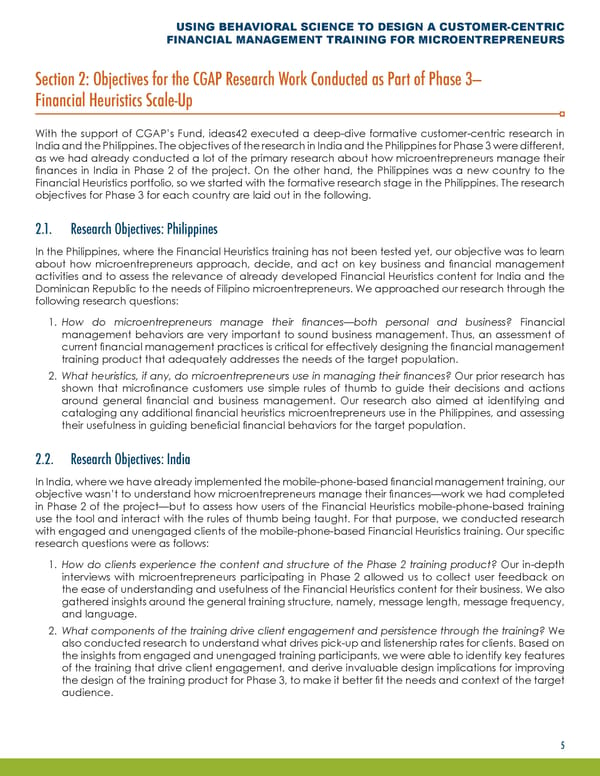USING BEHAVIORAL SCIENCE TO DESIGN A CUSTOMER-CENTRIC FINANCIAL MANAGEMENT TRAINING FOR MICROENTREPRENEURS Section 2: Objectives for the CGAP Research Work Conducted as Part of Phase 3— Financial Heuristics Scale-Up With the support of CGAP’s Fund, ideas42 executed a deep-dive formative customer-centric research in India and the Philippines. The objectives of the research in India and the Philippines for Phase 3 were different, as we had already conducted a lot of the primary research about how microentrepreneurs manage their finances in India in Phase 2 of the project. On the other hand, the Philippines was a new country to the Financial Heuristics portfolio, so we started with the formative research stage in the Philippines. The research objectives for Phase 3 for each country are laid out in the following. 2.1. Research Objectives: Philippines In the Philippines, where the Financial Heuristics training has not been tested yet, our objective was to learn about how microentrepreneurs approach, decide, and act on key business and financial management activities and to assess the relevance of already developed Financial Heuristics content for India and the Dominican Republic to the needs of Filipino microentrepreneurs. We approached our research through the following research questions: 1. How do microentrepreneurs manage their finances—both personal and business? Financial management behaviors are very important to sound business management. Thus, an assessment of current financial management practices is critical for effectively designing the financial management training product that adequately addresses the needs of the target population. 2. What heuristics, if any, do microentrepreneurs use in managing their finances? Our prior research has shown that microfinance customers use simple rules of thumb to guide their decisions and actions around general financial and business management. Our research also aimed at identifying and cataloging any additional financial heuristics microentrepreneurs use in the Philippines, and assessing their usefulness in guiding beneficial financial behaviors for the target population. 2.2. Research Objectives: India In India, where we have already implemented the mobile-phone-based financial management training, our objective wasn’t to understand how microentrepreneurs manage their finances—work we had completed in Phase 2 of the project—but to assess how users of the Financial Heuristics mobile-phone-based training use the tool and interact with the rules of thumb being taught. For that purpose, we conducted research with engaged and unengaged clients of the mobile-phone-based Financial Heuristics training. Our specific research questions were as follows: 1. How do clients experience the content and structure of the Phase 2 training product? Our in-depth interviews with microentrepreneurs participating in Phase 2 allowed us to collect user feedback on the ease of understanding and usefulness of the Financial Heuristics content for their business. We also gathered insights around the general training structure, namely, message length, message frequency, and language. 2. What components of the training drive client engagement and persistence through the training? We also conducted research to understand what drives pick-up and listenership rates for clients. Based on the insights from engaged and unengaged training participants, we were able to identify key features of the training that drive client engagement, and derive invaluable design implications for improving the design of the training product for Phase 3, to make it better fit the needs and context of the target audience. 5
 Using Behavioral Science to Design a Customer-Centric Financial Management Training for Microentrepreneurs Page 7 Page 9
Using Behavioral Science to Design a Customer-Centric Financial Management Training for Microentrepreneurs Page 7 Page 9